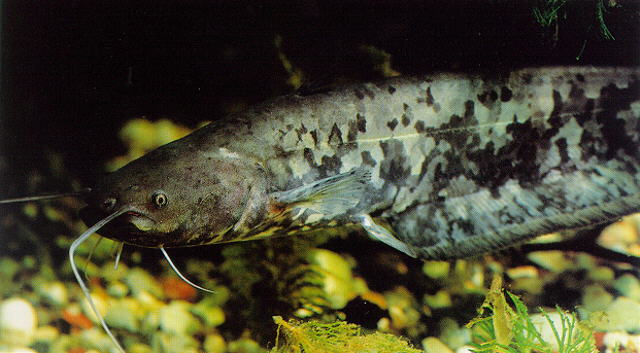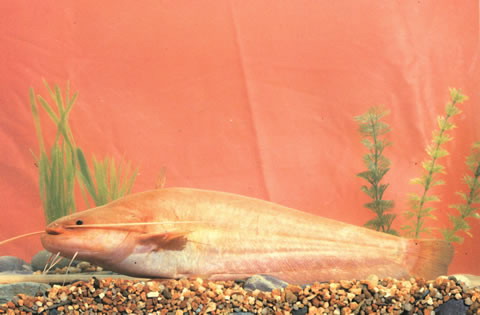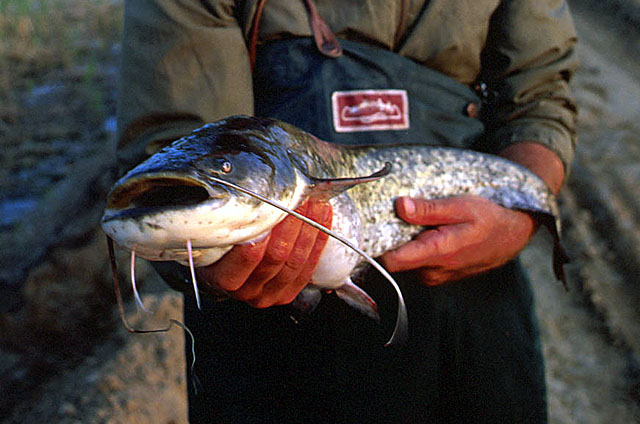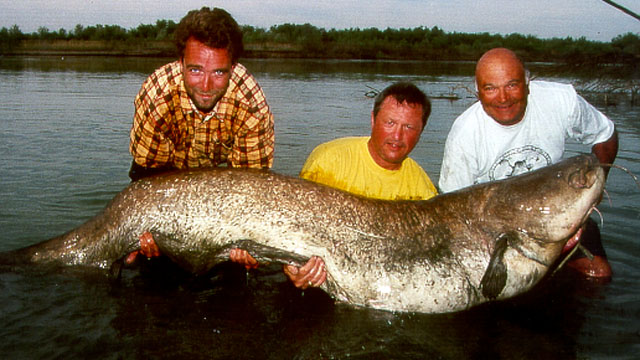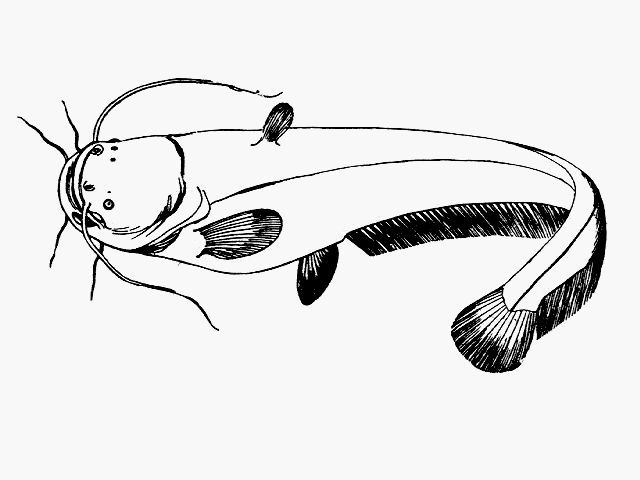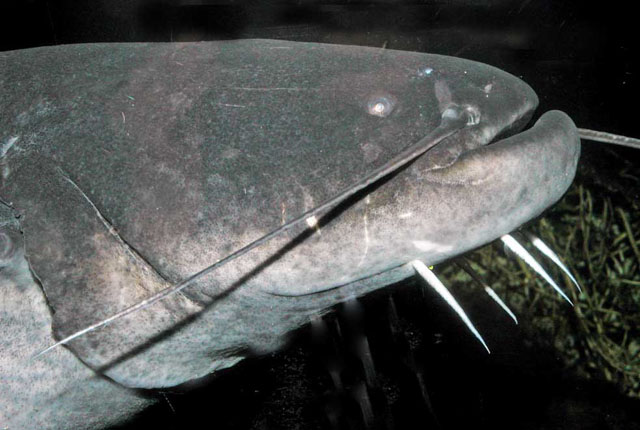Silurus
glanis
Linnaeus,
1758
Wels catfish
View all media / Upload your photos and videos
Expand all
Classification / Names
Teleostei (teleosts) > Siluriformes (Catfishes) >
Siluridae (Sheatfishes)
Etymology: Silurus: Greek, silouros = a cat fish + Greek, odous = teeth (Ref. 45335).
More on author:
Linnaeus.
Environment / milieu / depth range / climate zone / distribution range
Distribution
Europe and Asia. North, Baltic, Black, Caspian and Aral Sea basins, as far north as southern Sweden and Finland; Aegean Sea basin in Maritza and from Struma to Sperchios drainages; Turkey. Absent from the rest of Mediterranean basin. Now widely introduced and translocated throught Europe and Lake Balkhash basin in Kazakhstan. Several countries report adverse ecological impact after introduction.
Length at first maturity / Size / Weight / Age
Short description
Dorsal spines (total): 1; Dorsal soft rays (total): 4 - 5; Anal spines: 1; Anal soft rays: 83 - 95. Distinguished from all other freshwater fishes in Europe by the following unique characters: two pairs of mental barbels; and anal fin with 83-91½ rays. Differs further from the following combination of features: body naked; large, depressed head; dorsal fin with 2-4½ rays; caudal fin rounded or truncate; no adipose fin; and anal rays almost touching caudal (Ref. 59043). Caudal fin with 17 rays (Ref. 2196).
Biology
The maximum length of the species has been recorded as 5 m for a long time and the maximum weight as 306 kg . It has been demonstatred that misidentifications and problems of measurment units have led to these numbers. The recorded maxima with evidence are 2.73 m and 130 kg (Ref. 123627). Inhabits large and medium size lowland rivers, backwaters and well vegetated lakes (Ref. 59043). Occurs mainly in large lakes and rivers, though occasionally enters brackish water in the Baltic and Black Seas (Ref. 9988). Found in deep waters of dams constructed on the lower reaches of rivers (Ref. 9696). A nocturnal predator, foraging near bottom and in water column. Larvae and juveniles are benthic, feeding on a wide variety of invertebrates and fish. Adults prey on fish and other aquatic vertebrates. Attains first sexual maturity at 2-3 years of age (Ref. 59043). Spawns in the salt water of the Aral Sea (at Kulandy) (Ref. 1441). Marketed fresh, canned and frozen; can be pan-fried and baked (Ref. 9988). Locally threatened due to river regulation destroying shallow spawning sites (Ref. 59043).
Life cycle and mating behavior
Males defend small territories in the spawning sites and construct nests made of plant materials. They dig shallow depressions or clean spawning substrate such as willow (Salix) and roots. Males guard the nests until larvae emerge. Spawns in pairs. Eggs hatch in 2-3 days. Larvae live in the nest until yolk sac is absorbed for 2-4 (Ref. 59043). Eggs are surrounded by a mucous and adherent wrapping. Incubation lasts about 50 hours at 24°C. Egg size 3 mm, larval length at hatching 8.5 mm (Ref. 26211).
Main reference
Kottelat, M. and J. Freyhof 2007 Handbook of European freshwater fishes. Publications Kottelat, Cornol and Freyhof, Berlin. 646 pp. (Ref. 59043)
IUCN Red List Status (Ref. 125652)
Least Concern (LC); date assessed: January 01 2008
CITES (Ref. 123416)
Not Evaluated
CMS (Ref. 116361)
Not Evaluated
Threat to humans
Potential pest
More information
- Countries
- FAO areas
- Ecosystems
- Occurrences
- Introductions
- Stocks
- Ecology
- Diet
- Food items
- Food consumption
- Ration
- Common names
- Synonyms
- Metabolism
- Predators
- Ecotoxicology
- Reproduction
- Maturity
- Spawning
- Spawning aggregation
- Fecundity
- Eggs
- Egg development
- Age/Size
- Growth
- Length-weight
- Length-length
- Length-frequencies
- Morphometrics
- Morphology
- Larvae
- Larval dynamics
- Recruitment
- Abundance
- References
- Aquaculture
- Aquaculture profile
- Strains
- Genetics
- Allele frequencies
- Heritability
- Diseases
- Processing
- Mass conversion
- Vision
- Pictures
- Stamps, Coins Misc.
- Sounds
- Ciguatera
- Speed
- Swim. type
- Gill area
- Otoliths
- Brains
Estimates based on models
Phylogenetic diversity index (Ref. 82804): PD50 = 0.5001 [Uniqueness, from 0.5 = low to 2.0 = high].
Bayesian length-weight: a=0.00631 (0.00525 - 0.00759), b=2.99 (2.94 - 3.04), in cm total length, based on LWR estimates for this species (Ref. 93245).
Trophic level (Ref. 69278): 4.4 ±0.2 se; Based on diet studies.
Resilience (Ref. 120179): Low, minimum population doubling time 4.5 - 14 years (tm=3-4; tmax=30).
Fishing vulnerability (Ref. 59153): Very high vulnerability (84 of 100).
Price category (Ref. 80766): Unknown.
Nutrients (Ref. 124155): Calcium = 20.8 [8.1, 39.9] mg/100g; Iron = 0.331 [0.098, 0.866] mg/100g; Protein = 17.1 [15.2, 18.7] %; Omega3 = 0.286 [0.121, 0.672] g/100g; Selenium = 22.5 [10.0, 51.5] μg/100g; VitaminA = 8.18 [2.27, 37.75] μg/100g; Zinc = 0.442 [0.243, 1.135] mg/100g (wet weight); based on nutrient studies.

